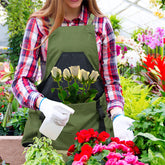How to Clean Garden Tools from Poison Ivy: A Comprehensive Guide
Table of Contents
- Introduction
- Understanding Poison Ivy and Urushiol
- The Importance of Cleaning Tools
- Materials Needed for Cleaning
- Step-by-Step Guide to Cleaning Tools
- Preventive Measures for Safe Gardening
- Conclusion and Summary of Key Points
- FAQs About Poison Ivy and Tool Cleaning
Introduction
Did you know that the oil from poison ivy can linger on surfaces for years, potentially causing skin rashes long after the plant has been removed? This surprising fact underscores the importance of properly cleaning our gardening tools after they’ve been exposed to this notorious plant. For avid gardeners like us, understanding how to effectively clean our tools from poison ivy oil, known as urushiol, is crucial to preventing unwanted reactions that can ruin our gardening experiences.
Poison ivy, along with its cousins poison oak and poison sumac, can be found in various regions across North America, making it essential for anyone who spends time outdoors to be aware of its presence. The oil in these plants can easily transfer to our hands, clothes, and tools, but with the right cleaning techniques, we can significantly reduce the risk of exposure.
In this blog post, we will explore the dangers of urushiol, the best methods for cleaning gardening tools, and preventive measures we can take to safeguard ourselves. By the end of this article, you will be equipped with the knowledge to maintain your gardening tools and ensure a safe, enjoyable gardening experience.
We will cover the following topics:
- Understanding Poison Ivy and Urushiol
- The Importance of Cleaning Tools
- Materials Needed for Cleaning
- Step-by-Step Guide to Cleaning Tools
- Preventive Measures for Safe Gardening
- Conclusion and Summary of Key Points
- FAQs About Poison Ivy and Tool Cleaning
Let’s dive into the world of gardening safety and hygiene!
Understanding Poison Ivy and Urushiol
What is Poison Ivy?
Poison ivy (Toxicodendron radicans) is a perennial plant that can appear as a vine, shrub, or ground cover. It is characterized by its three leaflets, which can vary in shape and size. Many gardeners unknowingly come into contact with poison ivy while tending to their gardens, as it often grows in wooded areas or along paths.
What is Urushiol?
Urushiol is the oily resin found in poison ivy, poison oak, and poison sumac. This substance is responsible for the itchy, blistering rash that many people experience after contact. Even a tiny amount of urushiol can trigger a reaction, making it essential to clean any gardening tools or equipment that may have been in contact with these plants.
The Risks of Exposure
Exposure to urushiol can lead to severe allergic reactions, including itching, swelling, and blisters. In some cases, individuals may require medical attention if the rash is extensive or if they experience difficulty breathing. Understanding the risks associated with urushiol is crucial for gardeners, especially those who may not be familiar with the appearance of poison ivy.
The Importance of Cleaning Tools
Preventing the Spread of Urushiol
Cleaning our gardening tools is not just a matter of hygiene; it is a critical step in preventing the spread of urushiol. If these oils are left on tools, they can easily transfer to our skin during future gardening sessions, leading to unwanted rashes and discomfort.
Maintaining Tool Longevity
Regular cleaning of gardening tools not only helps prevent allergic reactions but also enhances the longevity of the tools themselves. Dirt, sap, and plant residues can corrode metal surfaces and degrade wooden handles over time. By maintaining our tools, we ensure they remain functional and effective for years to come.
Materials Needed for Cleaning
To effectively clean our gardening tools from poison ivy oil, we will need the following materials:
- Protective Gear: Gloves, long sleeves, and goggles to protect our skin and eyes from urushiol.
- Cleaning Solution: A specialized poison ivy cleanser or a mixture of dish soap and warm water.
- Scrub Brush: A stiff-bristled brush to help remove any stubborn residues.
- Cloth or Towel: For wiping down the tools after cleaning.
- Bucket: To hold the soapy water solution.
- Rubbing Alcohol: As an alternative to specialized cleansers for tough-to-clean tools.
Step-by-Step Guide to Cleaning Tools
Now that we have gathered our materials, let’s walk through the steps to clean our gardening tools effectively.
Step 1: Prepare Your Workspace
Choose an outdoor area or a well-ventilated space to clean your tools. Lay down some newspaper or an old towel to catch any drips or debris.
Step 2: Wear Protective Gear
Before handling the tools, put on your gloves, long sleeves, and goggles. This will help prevent any accidental contact with urushiol.
Step 3: Rinse the Tools
Start by rinsing your tools with water to remove any loose dirt or debris. This initial rinse will make the cleaning process more effective.
Step 4: Apply the Cleaning Solution
If you’re using a commercial poison ivy cleanser, follow the instructions on the label. If you’re using dish soap, mix a few drops of soap with warm water in a bucket. Using the scrub brush, apply the cleaning solution to all surfaces of the tools, paying special attention to areas that may have come into contact with poison ivy.
Step 5: Scrub Thoroughly
Using the scrub brush, scrub each tool thoroughly. Ensure you clean not only the metal parts but also any wooden handles and joints where oil may linger.
Step 6: Rinse Again
After scrubbing, rinse the tools under running water to wash away the cleaning solution and any remaining urushiol.
Step 7: Dry the Tools
Using a clean cloth or towel, dry the tools completely. This step is essential to prevent rusting and damage to the tools.
Step 8: Disinfect (Optional)
For added safety, consider wiping down the tools with rubbing alcohol after they have dried. This will help eliminate any remaining traces of urushiol.
Step 9: Store Properly
Once your tools are clean and dry, store them in a designated area away from potential exposure to poison ivy. This will help ensure they remain clean and safe for future use.
Preventive Measures for Safe Gardening
Identify Poison Ivy
Familiarize yourself with the appearance of poison ivy and its variants. Knowing what to look for will help you avoid contact while gardening or exploring nature.
Use Protective Gear
Always wear gloves and long sleeves when gardening, especially in areas where poison ivy may grow. This simple precaution can significantly reduce the risk of exposure.
Clean Tools Regularly
Make it a habit to clean your gardening tools after each use, especially if you suspect they have come into contact with poison ivy. Regular maintenance will keep both you and your tools safe.
Educate Others
If you garden with family or friends, ensure they are aware of the dangers of poison ivy and the importance of cleaning tools. Sharing knowledge promotes a safer gardening environment for everyone.
Conclusion and Summary of Key Points
In conclusion, knowing how to clean garden tools from poison ivy is an essential skill for any gardener. By understanding the risks associated with urushiol and following proper cleaning methods, we can prevent allergic reactions and ensure our tools remain in good condition.
To summarize, here are the key points covered in this article:
- Poison ivy contains urushiol, an oil that can cause severe skin reactions.
- Cleaning gardening tools helps prevent the spread of urushiol and extends the life of the tools.
- Essential materials for cleaning include protective gear, a cleaning solution, a scrub brush, and towels.
- The step-by-step cleaning process involves rinsing, applying a cleaning solution, scrubbing, and drying tools properly.
- Preventive measures, such as wearing protective gear and educating others, can help avoid exposure to poison ivy.
By implementing these strategies, we can enjoy our gardening experience while staying safe and healthy.
FAQs About Poison Ivy and Tool Cleaning
1. How long does urushiol last on surfaces?
Urushiol can remain potent on surfaces for several years if not cleaned properly. This is why regular cleaning of tools is crucial.
2. Can you get poison ivy from touching contaminated tools?
Yes, if tools have been exposed to urushiol, touching them can transfer the oil to your skin and potentially cause a rash.
3. What’s the best way to remove urushiol from skin?
The best way to remove urushiol from skin is to wash the affected area with soap and water as soon as possible. Specialized cleansers are also available for this purpose.
4. Is bleach effective in cleaning tools from urushiol?
Bleach is not recommended for cleaning urushiol since it does not break down the oil. It’s best to use soap and water or specialized cleansers for effective removal.
5. Can I use the same cleaning method for other gardening equipment?
Yes, the same cleaning method can be applied to any gardening equipment that may have come into contact with poison ivy, including gloves, pots, and garden furniture.
By taking the necessary precautions and maintaining our gardening tools, we can continue to cultivate our green spaces without the worry of poison ivy. At Garden Greenland, we believe that everyone deserves to connect with nature safely and enjoyably, one gardening essential at a time!









